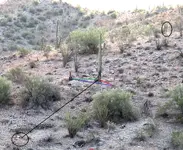Measuring at Treasure Vault sites (condensed)
Renaissance period: Rod for Measuring land
During the Renaissance era, bars were used as standards of length when surveying land. These bars often used a unit of measure called a Rod, of length equal to 5.5 yards, 5.0292 metres, 16.5 feet, or 1⁄320 of a statute mile.
A rod is the same length as a perch or a pole, and was standardized in 1620 by Edmund Gunter with his Gunter's Chain which is the length of 4 rods or 66 feet.
The rod unit was still in use as a common unit of measurement in the mid-19th century in the United States.
Dividing 16.5 feet (a rod length) by 3 = 5.5 Feet which seems to be the basis for many of the Measurements I have found in the field and could very possible be halved to 2.75 feet.
I have seen 49.5 feet which equals 3 Rods.
They also used 1/2 of a Rod as well which is 8.25 feet, I have seen 41.25 feet which is 2.5 Rods as well as 82.5 feet which equals 5 Rods.
This would also explain why I have ran into so many measurements that 33 inches divided into evenly, because 33 inches is 2.75 feet.
However this would change the numbers considerably, for instance:
82.5 feet is what I had always considered 30 varas because 82.5 feet divided by 2.75 feet or (33 inches) equals 30 (what I thought of as Varas)
But if we look at 82.5 feet measured by the Rod at 16.5 feet per rod we get 5 Rods.
Or we divide (82.5 feet) with 1/3 of a rod (5.5 feet) and we get 15 Rods. And so on.
(The measurements above are very precise in the field)
What is important here is that the only Renaissance era (ancient) Land Measuring Device I could find that aligns with the modern day American Measurements (using our same exact inch) are the Rod and Gunter Chain however they divided them up in ways that we don't use today. As far as I know Absolutely no other measuring device was invented that could be as close to our American measurements before the 1800s and the invention of the engineers chain which could measure down to one foot per link.
I thought I would also throw in how and when these measurements came about for minds that want to know.
In case your wondering why and when the rod became exactly 16.5 feet here is the answer:
The basic concept of the mile originated in Roman times. The Romans used a unit of distance called the mille passum, which literally translated into "a thousand paces." Since each pace was considered to be five Roman feet—which were a bit shorter than our modern feet—the mile ended up being 5,000 Roman feet, or roughly 4,850 of our modern feet.
If the mile originated with 5,000 Roman feet, how did we end up with a mile that is 5,280 feet? Blame the furlong. The furlong wasn't always just an arcane unit of measure that horseracing fans gabbed about; it once had significance as the length of the furrow a team of oxen could plow in a day. In 1592, Parliament set about determining the length of the mile and decided that each one should be made up of eight furlongs. Since a furlong was 660 feet, we ended up with a 5,280-foot mile.
So when we break the Mile down by 8 furlongs of 660 feet each or 1/8 of a mile we get: the Acre. Remember that a furlong was considered to be the length of a furrow a team of oxen could plow in one day without resting. An acre—which gets its name from an Old English word meaning "open field" and over time, the old Saxon inhabitants of England established that this area (an acre) was equivalent to a long, thin strip of land one furlong in length or 1 chain x 10 chains an old unit of length equivalent to 66 feet wide x 660 feet long. That's how we ended up with an acre that's equivalent to 43,560 square feet, and a chain of 66 feet which when broken down becomes the rod of 16.5 feet or 1/4 of a chain.




